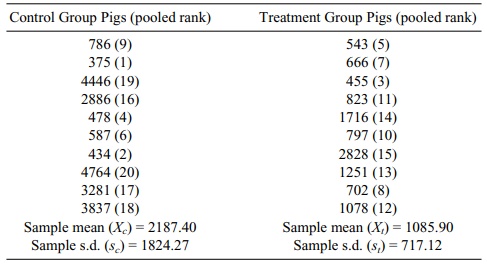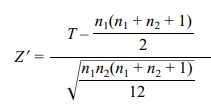Wilcoxon Rank-Sum Test
| Home | | Advanced Mathematics |Chapter: Biostatistics for the Health Sciences: Nonparametric Methods
A nonparametric analog to the unpaired t test, the Wilcoxon rank-sum test is used to compare central tendency, i.e., the locations of two independent samples selected from two populations.
WILCOXON RANK-SUM TEST (THE MANN–WHITNEY TEST)
A nonparametric analog to the unpaired t test, the Wilcoxon rank-sum test is
used to compare central tendency, i.e., the locations of two independent
samples selected from two populations. Conover (1999) is an important reference
for this test. The data must be taken from a continuous scale and represent at
least ordinal measure-ment. The Wilcoxon test statistic is calculated by taking
the sum of the ranks of n1
observations from group one. There are also n2
observations in group two, but only group one is needed to perform the test.
The sum of all the ranks (T + T’) is (n1 + n2)(n1 + n2 + 1)/2. Referring to Table 14.2: (5 + 5)(5 + 5 + 1)/2 = 55. You
can veri-fy this sum by checking Table 14.2. Since n1/(n1
+ n2) is the probability
that a randomly selected observation is from group one, multiplying these two
numbers to-gether gives the expected rank sum for group one. This value is (n1)(n1 + n2
+ 1)/2 = (5)(11)/2 = 27.5. We will use the rank sum for group one as the test
statistic. The distribution of the rank sum can be found in tables for small to
moderate values of n1 and
n2. For n1 = 5 and n2 = 5, the
critical value is 18. A rank sum that is less than 18 or greater than 55 – 18 = 37 is significant (p < 0.05, two-tailed test). Thus, in
our example, since T = 25 the
difference between the treatment and control groups is not statistically
significant.
Here is a second example that uses small sample
sizes. Recall in Section 8.7 the table for pig blood loss data to compare the
treatment and the control groups. In Section 9.9, we used these data to
demonstrate the two-sample t test
when both of the variances for the parent population are assumed to be unknown
and equal. Note that if the variances are equal, we are only entertaining the
possibility of a differ-ence in the center or median of the distribution.
Because these data did not fit well to the normal distribution, we might
perform a Wilcoxon rank-sum test to deter-mine whether we can detect
differences between the medians of the two popula-tions. Table 14.3 shows the
data and the pooled ranks.
TABLE 14.3. Pig Blood Loss Data (ml)

The ranks in Table 14.3 are obtained as follows. First we list all the data irre-spective of control group or treatment group assignment: 786, 375, 4446, 2886, 478, 587, 434, 4764, 3281, 3837, 543, 666, 455, 823, 1716, 797, 2828, 1251, 702, 1078. Next we rearrange these values from smallest to largest: 375, 434, 455, 478, 543, 587, 666, 702, 786, 797, 823, 1078, 1251, 1716, 2828, 2886, 3281, 3837, 4446, 4764.
The ranks
are then given as follows: 375 → 1, 434 → 2, 455 →
3, 478 → 4, 543 → 5, 587 →
6, 666 → 7, 702 → 8, 786 →
9, 797 → 10, 823 → 11, 1078 →
12, 1251 → 13, 1716 → 14, 2828 →
15, 2886 → 16, 3281 → 17, 3837 →
18, 4446 → 19, 4764 → 20. These ranks are then associated with observations in each group; the
ranks are given next to the numbers in Table 14.3. The test statistic T is then the sum of the ranks in the
control group, namely, 9 + 1 + 19 + 16 + 4 + 6 + 2 + 20 + 17 + 18 = 112. The
sum of the ranks for the treatment group T’
is 5 + 7 + 3 + 11 + 14 + 10 + 15 + 13 + 8 + 12 = 98. The higher rank sum
for the control group is consistent with the tendency for greater blood loss in
the control group. Note that n1
= n2 = 10 and n1 + n2 = 20. The sum of all the ranks (T + T’) = 1 + 2 + 3 + . . . , 20 = 210. T + T’ = (n1 +
n2)(n1 +
n2 + 1)/2 = (20)(21)/2
= 210. We also know that T = 112.
Alter-natively, we can calculate T’ =
210 – T = 210 – 112 = 98.
Consulting tables for the Mann–Whitney (Wilcoxon)
test statistic, we see that the 10th percentile critical value is 88 and the
90th percentile critical value is 122. We observed that T = 112 and T’ = 98. The
two-sided p-value of the observed
sta-tistic must be greater than 0.20. When the null hypothesis is true, the
probability is 0.80 that the rank sum statistics fall between 88 and 122. Both T and T’ fall within the range of 98 on the low side and 112 on the high
side. So the difference in the rank sums is not statistically significant at α = 0.20.
Recall that in Chapter 9 (using the same data as in
this example), we found a one-sided p-value
of less than 0.05 when applying the t
test; i.e., the results were significant. Why did the t test give a different answer from the Wilcoxon test, and which
test should we believe? First of all, two dubious assumptions were made in
applying the t test: the first was
that the two distributions were normal and the second was that they both had
the same variance. Histograms for the two samples would probably convince you
that the distributions are not normal. Also, the sample standard deviation for
the control group is approximately 2½ times as large as for the treatment
group, indicating that the variances are not equal. Because we are on shaky
ground with the parametric assumptions, we should trust the nonparametric
analysis and conclude that there is insufficient information to detect a
difference be-tween the two populations. The nonsignificant results for the
Wilcoxon test do not mean that the central tendencies of the two groups are the
same. Tests such as the Wilcoxon rank-sum test are not very powerful at
detecting differences in means (or medians) when the variances of the two
samples differ greatly, as is true of this case. As the sample size is only 10
for each group, we may wish that we had col-lected data on more pigs so that a
difference in the blood loss distributions could have been detected.
Most of the time, we will be using the normal
approximation for the Wilcoxon rank-sum test. Consequently, we have not
included tables of critical values for this test for use with small sample
sizes. For large values (n1
or n2 greater than 20) a
normal approximation can be used. As before, we will use the sum of the ranks
from the first sample. The test statistic for the sum of the ranks for the
control group is denoted as T. To use
the normal approximation when there are many ties, take

where S
is the standard deviation for T and n1(n1 + n2
+ 1)/2 is the expected value of the rank sum under the null hypothesis. S is the square root of S2, where

Here ΣR2i is the sum of the squares of the ranks for all the data. This result is
given in Conover (1999), page 273, using slightly different notation.
When there are no ties, Conover (1999) recommends a
simpler approximation, namely,

To summarize, Equation 14.1 describes the normal
approximation for the Wilcoxon rank-sum test for comparing two independent
samples (no ties) that can be used when n1
and n2 are large enough.
Let T be the sum of the ranks for the
pooled observations from one of the groups (samples). Then

where T
is the sum of the ranks in one of the groups (e.g., control group) and n1 and n2 are,
respectively, the sample sizes for samples from population 1 and population 2.
In the event of ties, the following normal
approximation Wilcoxon rank-sum test for comparing two independent samples
(ties) should be used when n1
and n2 are large enough
(i.e., greater than 20). Let T be the
sum of the ranks for the pooled ob-servations from one of the groups (samples).
Then

where T
is the sum of the ranks from one of the groups (e.g., control group); n1 and n2 are,
respectively, the sample sizes for sample 1 and sample 2; and

where ΣNi=1R2i is the sum of the squares of the ranks for all the
data (N = n1 + n2).
In the next two sections, we will look at the nonparametric analogs to the
paired t test. They are the Wilcoxon
signed-rank test (in Section 14.4) and the simpler but less powerful sign test (in Section 14.5).
Related Topics
